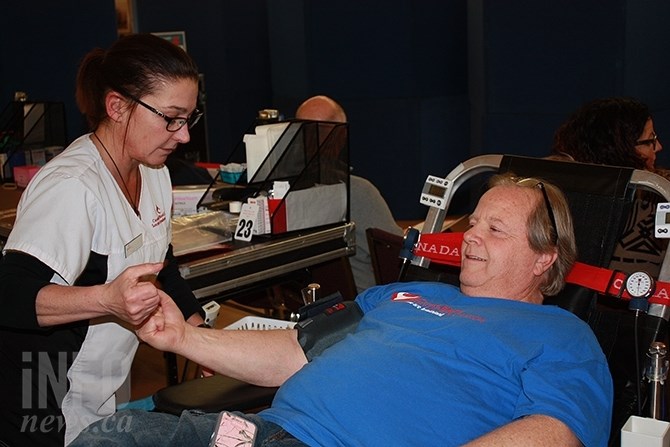
FILE PHOTO- Penticton city councillor Andre Martin donates blood at a Penticton clinic last December. Canadian Blood Services has embarked on an international campaign to raise awareness on the importance of donating blood, while the service makes changes to try and lessen time donors spend in the clinics.
(STEVE ARSTAD / iNFOnews.ca)
August 22, 2016 - 1:05 PM
PENTICTON - Blood donations are on the decline in the world’s most developed countries, and Canada is no exception.
So says David Patterson, the director of donor relations with Canadian Blood Services. He says there has been a 30 per cent drop in blood donors internationally.
Canada is doing better with a drop of about nine per cent from 2005 to 2015, he says, and the decline is uniform across Canada, including blood donor clinics in the Thompson-Okanagan.
“The Missing Type campaign was launched in Great Britain last year and it helped to make the public understand the need for new donors,” he said, adding it was now a global initiative, with Canada participating.
Patterson says the reasons for donor decline are varied. People are travelling more, and becoming exposed to new viruses and diseases such as the Zika virus, which he says has added one per cent to deferrals over the past six months.
“There are more pathogens in the blood supply," he says, adding donors are asked to return to the clinic following a waiting period after travelling to certain regions.
For countries with the Zika virus, a 21-day wait is required.
“More people are getting tattoos. If a donor has just had one, we’ll ask him or her to wait six months after they’ve had a tattoo,” he says.
Patterson also notes most people are leading busier lives.
“The pace of life has increased for everybody. Donating blood is not like asking to drop off five dollars, we’re asking for people’s time,” he says, adding time spent donating is a major has been identified as a major source of irritation for the blood service’s donors.
On July 1 the service launched a new program introducing digital clinics.
Patterson hopes it will streamline the process, with questionnaires filled out on line and abbreviated questionnaires for people who have donated recently.
“At the clinic, donors can go directly to screening, by passing those without an appointment, or those who didn’t fill in the online form,” he says.
Canadian Blood Services has 400,000 regular donors across the country but they're not getting any younger.
"We need to have the next generation coming in and we need to do a better job of making people understand how important an act it is,” Patterson says.
"Most people who donate have a great personal story to tell about why they donate. We’d like people to think in advance and see donating as a way to pay it forward,” he says.
“We’ve got 400,000 regular donors across the country, but the donor base getting older. We really need to bring new donors into the system,” he says.
“There are many worthwhile ways to give, but donating blood can improve or save someone’s life, so it’s a pretty powerful thing to do,” he adds. “We need to do a better job of making people understand how important it is, and our need for regular supply,” Patterson says.
There’s always a need fresh supply of blood, in particular need O negative, because anyone can use that blood type, he says.
More about the blood service’s campaign can be found on the Missing Types website.
To contact a reporter for this story, email Steve Arstad or call 250-488-3065 or email the editor. You can also submit photos, videos or news tips to the newsroom and be entered to win a monthly prize draw.
We welcome your comments and opinions on our stories but play nice. We won't censor or delete comments unless they contain off-topic statements or links, unnecessary vulgarity, false facts, spam or obviously fake profiles. If you have any concerns about what you see in comments, email the editor in the link above.
News from © iNFOnews, 2016